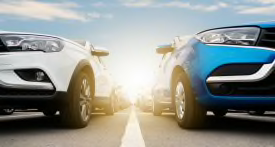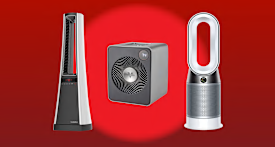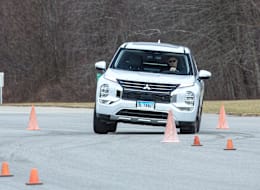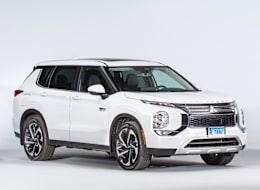The plug-in hybrid electric vehicle (PHEV) version of the Mitsubishi Outlander is much quicker and quieter then the regular model. It’s also distinguished by its ability to drive for an EPA-estimated 38 miles under electric power. In most other ways the Outlander PHEV is similar to the regular model. That means it’s a pretty decent-driving small SUV that’s based on the Nissan Rogue, but with the benefit of a standard (albeit very small) third-row seat.
The Outlander PHEV works pretty well, with a nicely-sorted plug-in powertrain that gives a “true EV feel” when it has a charged-up battery to work with. We also appreciate the slightly smoother ride that the PHEV model brings, thanks to the extra weight of its large battery. Although it posted a considerably higher road-test score than the regular Outlander, it’s disappointing that the PHEV version only matches—rather than improves upon—the fuel economy of the nonhybrid model.
For consumers new to PHEVs, these vehicles are hybrids with larger batteries that can be plugged into a 120-volt outlet or 240-volt EV charger. This gives them a dedicated electric-only driving range (typically for about 20 to 40 miles, depending on the vehicle) for commuting and around-town errands, which is something that regular hybrids can’t do. When the battery is drained, the vehicle switches to regular hybrid operation. This also means that, unlike a full battery-electric vehicle, there is no need to find a public charger on a long trip because the gas engine takes over once the electric range is used up.
For buyers who are nervous about going all-in for an EV, a plug-in hybrid could be a logical and cautious first step toward electrification. PHEVs make especially good sense if you have a short commute to work, rarely drive long distances, and have the ability and willingness to plug in your vehicle at home to charge overnight—it’s bound to save you lots of money at the gas pump. Plus, unlike regular hybrids, a PHEV may be eligible for federal tax credits. Considering that the average American drives less than 40 miles per day, this means many people will be able to do most of their daily commute on electric power while reserving the gas engine for longer trips.
It takes 6.5 hours to charge the Outlander PHEV’s 20-kilowatt-hour battery using a 240-volt (Level 2) EV charger, or more than 16 hours on a regular 120-volt household outlet using the supplied mobile charging cable. That means that owners will likely want to invest in a wall charger for their garage.
The Outlander PHEV feels very much like a full EV when driven in electric mode, mostly due to the fact that it doesn’t have a conventional automatic transmission or an electronic continuously variable transmission (eCVT) as in most PHEVs and hybrids. Instead, it uses a direct-drive just like an EV. We found that the Outlander’s setup is both a blessing and a curse; at low speeds in EV mode the Outlander operates very smoothly and provides a healthy dose of electric power when you need it. But when operating as a hybrid, it falls short on efficiency as evidenced by its 25 mpg consumption in our testing, which matches—rather than exceeds—that of the regular, nonhybrid Outlander.
This means that if you spend a lot of time driving on highways, potential buyers would do better sticking with the regular Outlander, as it’s more fuel-efficient at higher speeds. The benefit of PHEVs is much more tangible for those who stick to a local urban environment and charge frequently.
Side benefits of the PHEV include much quicker acceleration, despite the 885 pounds of added weight. That’s because the PHEV version—which combines a 2.0-liter four-cylinder engine, front and rear electric motors, and a 20-kWh battery—produces a healthy 248 horsepower from the total system, compared to just 181 hp for the regular Outlander. This helps the Outlander PHEV scoot from 0 to 60 mph 2.5-seconds quicker than the underpowered regular Outlander.
The PHEV version is also significantly quieter, owing in part to the ability to drive on electric power for those first 38 miles or so. The only slightly objectionable source of noise stems from the gasoline engine when it revs discordantly high compared to the actual acceleration, reminiscent of vehicles that use a CVT.
Another advantage for the Outlander PHEV is its slightly more comfortable ride. While it’s still stiff over bumps and ruts, it doesn’t smack as harshly or with the severity of the regular model. Handling is responsive although the steering feels too light for how quickly it turns into corners, which makes it feel darty. Still, the PHEV proved secure in our emergency maneuvers on our track.
Fit and finish is quite good throughout the cabin, with plenty of padded pieces. The well-shaped front seats are comfortable, and we liked the grippy suede center sections. The second-row seat offers lots of leg- and foot room, along with easy access thanks to the 90-degree door openings. The third-row seat, unique for the small SUV class, gives the ability to haul seven people in a pinch, but it’s tiny. Plus, the four-step process to fold the third-row down is annoyingly complicated.
Most of the Outlander’s controls are very user-friendly, particularly the infotainment system. But some PHEV-specific functions, such as the button to adjust the regenerative-braking settings, aren’t clear or convenient to use. Annoyingly, in order to unplug the vehicle after charging, you have to press a button on the dash, or first lock the doors and then unlock them in order to release the cable.
Standard active safety systems and driver assistance features include automatic emergency braking with pedestrian detection, automatic emergency braking that operates at highway speeds, blind spot warning, rear cross traffic warning, reverse automatic emergency braking, lane departure warning, and automatic high beams. Lane centering assistance, lane keeping assistance, and adaptive cruise control are available. We found that the adaptive cruise control system works well, but the lane centering assistance doesn’t apply enough force to keep the Outlander centered in the lane through curves.


























